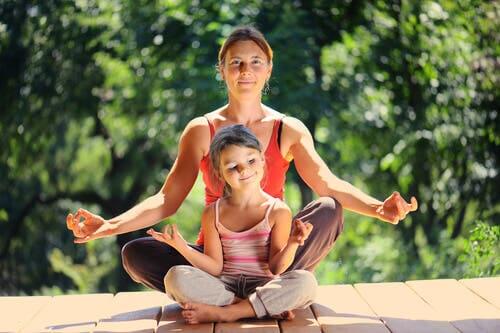Mindfulness and Meditation Activities for the Whole Family

Could mindfulness and family meditation bring more Zen into your daily life? Mindfulness and meditation are known to reduce anxiety, increase empathy, and promote happiness and well-being in people of all ages and cultures.
Meditating with children may seem like a stressful prospect. However, this simple and ancient practice can take many forms and can be a great activity for children. Start with these fun and easy exercises to introduce children to inner peace. At the same time, you’ll help the whole family feel that the most stressful situations can be controlled from within.
Breathing as a family: mindfulness and meditation
Breathing is one of those biological reflexes we take for granted. Of course we’re doing it correctly, right? Learning to take deep, cleansing breaths is an easy, instantaneous way to give us a few moments of quiet concentration.
Have your child rest their hands on their stomach, with their eyes closed. Encourage them to take a deep breath through their nose and count up to five. Get them to hold their nose for two seconds and then count backwards as they exhale every last bit of breath. Ask them to notice how their chest rises and falls as it fills their lungs with air and then releases it.
If you think this activity will be a bit too quiet for your little one, then whisper animal noises as they exhale, such as the buzzing of a bee or the mooing of a cow. This quiet mindfulness and meditation activity is perfect for waiting rooms and other anxious moments.

Listen carefully
Full attention is about tuning into the here and now and accepting it without attachment or judgment. Children are constantly on the move, physically and mentally, back and forth between what happened at the end of the last activity and what the next activity will be. They’re still developing their capacity to center their thoughts and appreciate the here and now.
Challenge your children with a game and tell them to sit cross-legged with their eyes closed. Ask them to listen carefully as you play a bell, wind chimes, or a musical chord, and to raise their hand once they can no longer hear any sounds.
Patience and listening are important skills for each stage of life. With this activity, your children will learn to listen and be patient, something that’s fundamental for both their personal and professional lives in the future.
Meditation and mindfulness before going to sleep
Things are often a bit chaotic at bedtime, and this makes nighttime meditation difficult. However, it’s also ideal if you can incorporate it into your routine. Guided meditation, which is carried out lying down while the body is relaxed, is a good idea for the whole family. Its aim is to calm the mind with the help of relaxing audio instructions.
For example, you can ask your child to imagine that they’re a tree and to visualize its roots and branches, leaves or flowers, the field or forest where it’s growing, and how it came to be there. Ask them to feel the imaginary warmth of the sun and how the earth feels underneath it.
Speak slowly and add long, exaggerated breaths amidst pauses – it’s basically the most relaxing bedtime story around! You can search YouTube for “nighttime meditation for kids” to find a relaxing video or ideas for your own guided meditation routine before the kids go to sleep.

Meditation on the move
Kids love to move. The stillness factor can be a challenge when you try to meditate with children. Yoga, which is like meditation in motion, helps develop physical and mental strength and flexibility by teaching patience, concentration, breathing, and endurance.
Make it a family activity by looking for yoga classes for children with a healthy role model while, at the same time, enjoying family bonding time.
Meditation isn’t just for monks on a mountaintop. It’s a fun and accessible activity that anyone can practice anywhere. Introducing children to this relaxing concept during their early years can provide life-long benefits and a domino effect.
So what’s the most important thing to remember when trying to teach your little ones about mindfulness? Letting go. The more expectations you have, in meditation and in all aspects of life, the easier your days will be. Meditation and mindfulness can teach them how to enjoy life and the challenges it presents.
Could mindfulness and family meditation bring more Zen into your daily life? Mindfulness and meditation are known to reduce anxiety, increase empathy, and promote happiness and well-being in people of all ages and cultures.
Meditating with children may seem like a stressful prospect. However, this simple and ancient practice can take many forms and can be a great activity for children. Start with these fun and easy exercises to introduce children to inner peace. At the same time, you’ll help the whole family feel that the most stressful situations can be controlled from within.
Breathing as a family: mindfulness and meditation
Breathing is one of those biological reflexes we take for granted. Of course we’re doing it correctly, right? Learning to take deep, cleansing breaths is an easy, instantaneous way to give us a few moments of quiet concentration.
Have your child rest their hands on their stomach, with their eyes closed. Encourage them to take a deep breath through their nose and count up to five. Get them to hold their nose for two seconds and then count backwards as they exhale every last bit of breath. Ask them to notice how their chest rises and falls as it fills their lungs with air and then releases it.
If you think this activity will be a bit too quiet for your little one, then whisper animal noises as they exhale, such as the buzzing of a bee or the mooing of a cow. This quiet mindfulness and meditation activity is perfect for waiting rooms and other anxious moments.

Listen carefully
Full attention is about tuning into the here and now and accepting it without attachment or judgment. Children are constantly on the move, physically and mentally, back and forth between what happened at the end of the last activity and what the next activity will be. They’re still developing their capacity to center their thoughts and appreciate the here and now.
Challenge your children with a game and tell them to sit cross-legged with their eyes closed. Ask them to listen carefully as you play a bell, wind chimes, or a musical chord, and to raise their hand once they can no longer hear any sounds.
Patience and listening are important skills for each stage of life. With this activity, your children will learn to listen and be patient, something that’s fundamental for both their personal and professional lives in the future.
Meditation and mindfulness before going to sleep
Things are often a bit chaotic at bedtime, and this makes nighttime meditation difficult. However, it’s also ideal if you can incorporate it into your routine. Guided meditation, which is carried out lying down while the body is relaxed, is a good idea for the whole family. Its aim is to calm the mind with the help of relaxing audio instructions.
For example, you can ask your child to imagine that they’re a tree and to visualize its roots and branches, leaves or flowers, the field or forest where it’s growing, and how it came to be there. Ask them to feel the imaginary warmth of the sun and how the earth feels underneath it.
Speak slowly and add long, exaggerated breaths amidst pauses – it’s basically the most relaxing bedtime story around! You can search YouTube for “nighttime meditation for kids” to find a relaxing video or ideas for your own guided meditation routine before the kids go to sleep.

Meditation on the move
Kids love to move. The stillness factor can be a challenge when you try to meditate with children. Yoga, which is like meditation in motion, helps develop physical and mental strength and flexibility by teaching patience, concentration, breathing, and endurance.
Make it a family activity by looking for yoga classes for children with a healthy role model while, at the same time, enjoying family bonding time.
Meditation isn’t just for monks on a mountaintop. It’s a fun and accessible activity that anyone can practice anywhere. Introducing children to this relaxing concept during their early years can provide life-long benefits and a domino effect.
So what’s the most important thing to remember when trying to teach your little ones about mindfulness? Letting go. The more expectations you have, in meditation and in all aspects of life, the easier your days will be. Meditation and mindfulness can teach them how to enjoy life and the challenges it presents.
This text is provided for informational purposes only and does not replace consultation with a professional. If in doubt, consult your specialist.








